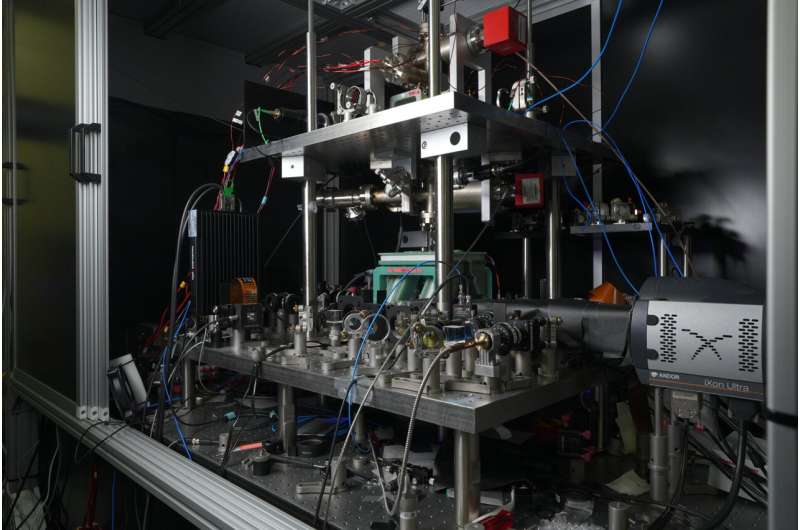AI-Driven Method Constructs Flawless Arrays Consisting of Thousands of Atoms

August 25, 2025 feature
by Ingrid Fadelli, Phys.org
contributing writer
edited by Gaby Clark, reviewed by Robert Egan
scientific editor
associate editor
This article has been reviewed according to Science X's editorial process and policies. Editors have highlighted the following attributes while ensuring the content's credibility:
fact-checked
peer-reviewed publication
trusted source
proofread
The simulation of quantum systems and the development of systems that can perform computations leveraging quantum mechanical effects rely on the ability to arrange atoms in specific patterns with high levels of precision. To arrange atoms in ordered patterns known as arrays, physicists typically use optical tweezers, highly focused laser beams that can trap particles.
Researchers at the University of Science and Technology of China and the Shanghai Artificial Intelligence Laboratory recently introduced a new artificial intelligence (AI)-enabled protocol that could facilitate the arrangement of thousands of atoms into arrays, while also ensuring that these arrays are defect-free (i.e., that there are no missing atoms).
Their proposed approach, introduced in a paper published in Physical Review Letters, rapidly corrects arrays in real-time using holograms (i.e., computer-generated light holograms) that are projected via a device known as a spatial modulator, along with AI algorithms that can plan the simultaneous shift of all trapped atoms to desired positions.
'Our initial interest in neutral atom arrays actually began with the fundamental interest into the century-old Einstein-Bohr debate on the recoiling-slit thought experiment,' Prof. Chao-Yang Lu, co-senior author of the paper, told Phys.org. 'Our quest to faithfully realize Einstein's thought experiment using a single tweezer-trapped atom cooled to the ground state in three dimensions as a quantum-limited recoiling-slit started about five years ago. Meanwhile, we also recognized the tremendous potential of atom arrays as a clean and beautiful platform for quantum computing.'
The aim of this recent study was to combine AI techniques with quantum physics to tackle a well-documented challenge encountered when assembling atom arrays. One of the principal investigators was Dr. Han-Sen Zhong, a former student of Lu who completed his Ph.D. at the University of Science and Technology of China and started working at Shanghai AI Lab.
'We recognize that AI for Science is emerging as a powerful paradigm for addressing complex scientific problems, and have ongoing discussions about this with Han-Sen,' said Lu. 'This led us to use AI to solve one of the longstanding challenges in the atom array field: how to rearrange large-scale atomic arrays in an efficient, fast, and scalable manner. This is a very nice example of 'AI4Q' (AI for Quantum).'
Zhong, who was a student in Lu's research group at the time of the study, designed an AI-driven framework that can plan the simultaneous shift of all atoms in an optical tweezer array. In the team's experiments, the optical tweezer array was generated using a high-speed spatial light modulator (SLM), a device that can imprint a hologram onto the incident laser beam.
'We use the AI model to calculate the holograms for real-time atom rearrangement,' explained Zhong. 'With precise control over both the position and phase of the tweezer array, all the atoms are moved simultaneously. Experimentally, we demonstrated the assembly of defect-free 2D and 3D atom arrays with up to 2024 atoms in just 60 milliseconds. Notably, the time cost remains constant regardless of array size, making the method readily scalable to 10,000 or even 100,000 atoms in the future.'
Discover the latest in science, tech, and space with over 100,000 subscribers who rely on Phys.org for daily insights. Sign up for our free newsletter and get updates on breakthroughs, innovations, and research that matter—daily or weekly.
The researchers' proposed method analyzes randomly loaded atom arrays and calculates the optimal path from atoms loaded in optical tweezers to target sites that are missing atoms. This path is then divided into a set of underlying steps.
'The entire path is divided into N steps and for each small step, we use an AI model to calculate the hologram for the SLM, with precise control over both the position and phase of the tweezer array,' said Zhong. 'In real time, all the atoms are moved simultaneously. Our method achieves a high level of parallelism and thus a rapid and constant-time performance.'
A characterizing feature of the team's approach for assembling defect-free neutral atom arrays is that it enables the parallel movement of all atoms to produce defect-free arrays. This is in contrast with previously introduced methods, which instead move atoms in sequences.
'We achieved a rapid and constant-time rearrangement, regardless of the array size,' said Lu.
This study could open new possibilities for the realization of quantum systems comprised of defect-free atom arrays. These systems could in turn be used to reliably perform quantum simulations or computations.
'Our next goal will be to demonstrate quantum error correction and fault-tolerant quantum computing based on atomic qubits,' added Prof. Jian-Wei Pan, co-senior author of the paper.
Written for you by our author Ingrid Fadelli, edited by Gaby Clark, and fact-checked and reviewed by Robert Egan—this article is the result of careful human work. We rely on readers like you to keep independent science journalism alive. If this reporting matters to you, please consider a donation (especially monthly). You'll get an ad-free account as a thank-you.
More information: Rui Lin et al, AI-Enabled Parallel Assembly of Thousands of Defect-Free Neutral Atom Arrays, Physical Review Letters (2025). DOI: 10.1103/2ym8-vs82. On arXiv: DOI: 10.48550/arxiv.2412.14647
Journal information: Physical Review Letters, arXiv
© 2025 Science X Network




